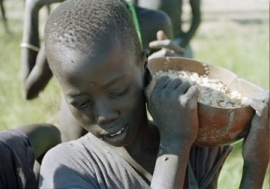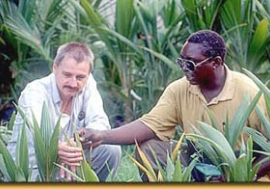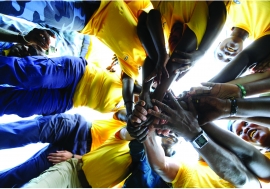Giant step for Kenya’s schools
The first day of classes at the Doonholm Primary School, near Nairobi, in January 2003 was more than the usual uproar of returning students, anxious parents and impatient teachers. Just weeks earlier, Headmaster Margaret Ayiemba told Africa Renewal, the newly elected Kenyan government had announced the abolition of school fees, and “the teachers were not really prepared. We didn’t know what would happen.” Could the school accommodate the expected surge of new arrivals? More than 200 eager new students did arrive, adding to nearly 1,300 already squeezed into the existing facilities.
And so Mrs. Ayiemba and her staff did what thousands of other Kenyan educators did on that day: improvise. Class sizes soared — sometimes to twice their previous number. Where previously a child was fortunate to be able to take a book home to study once in a week, the wait became two. Desks, pencils and paper, already in short supply, were stretched still further. Teachers hastily organized remedial programmes for the many older students seeking to enter Standard 1 — among the influx of poorer students previously barred from Doonholm by the cost.
 With the abolition of primary school fees, 1.3 million new students have poured into Kenya's schools.
With the abolition of primary school fees, 1.3 million new students have poured into Kenya's schools.Two years later, Mrs. Ayiemba said, the school still suffers from overcrowding and shortages, and many of the poorer children attend school hungry, because Doonholm has not been able to finance a feeding programme. There is an urgent need for everything from teachers and books to classrooms and toilets. “Still,” she concluded, “the parents are happy because there are no fees. The children can finally go to school and we have been able to maintain academic standards despite these problems. I can say from our side that the ending of school fees has been a success.”
Big stride forward
In all, some 1.3 million new students flooded into Kenya’s primary schools that day in January 2003, making good on a key election campaign promise by the new president, Mr. Mwai Kibaki, and taking the East African country a big step closer to the Millennium Development Goal (MDG) for education. The goals, adopted by world leaders in New York in September 2000, set ambitious international poverty-reduction and development targets (see page 12). In education, the MDGs require countries to provide a complete primary education for all children by 2015, reduce adult illiteracy and achieve gender parity at all levels of education by the end of this year, or no later than 2015.
The economic and social benefits of providing universal primary education and eliminating gender disparities are now widely recognized. Speaking at the launch of a non-governmental report on girls’ education in March, UN Secretary-General Kofi Annan noted that “study after study has taught us that there is no tool for development more effective than the education of girls. No other policy is as likely to raise economic productivity, lower infant and maternal mortality, improve nutrition and promote health, including the prevention of HIV/AIDS. No other policy is as powerful in increasing the chances of education for the next generation.”
“Study after study has taught us that there is no tool for development more effective than the education of girls. No other policy is as likely to raise economic productivity, lower infant and maternal mortality, improve nutrition and promote health, including the prevention of HIV/AIDS.”
– Kofi Annan, UN Secretary-General
A 2002 analysis published by the University of Munich, in Germany, estimated that eliminating the gender gap in education in Mali would prevent 35,000 infant deaths annually. A World Bank study that year argued that Africa’s gender gap in education had, by 1992, cost the continent nearly a percentage point in annual per capita growth since 1960.
Despite the benefits, it was only at the 1990 Education for All conference in Jomtien, Thailand, that a global commitment to universal primary education and gender parity was adopted (see Africa Recovery, July 2000). The targets agreed to at Jomtien were adopted by the UN Millennium Assembly a decade later and became the MDGs in education.
In Kenya, the elimination of school fees, an obstacle to education for impoverished families in many African countries, has, at a stroke, put the country “on track” to reach the MDG enrolment and gender parity objectives, at least in primary education. In 2004 the UN Children’s Fund (UNICEF) estimated that the country’s total primary school enrolment was nearly 7.4 million, compared to less than 6 million in the Millennium year of 2000. Equally impressive has been Kenya’s success in reducing dropout rates — from 4.9 per cent in 1999 to just 2 per cent in 2003 — despite the difficulties that followed the introduction of free education.
Although the ratio of girls to boys has dropped slightly in recent years, it remains among the best in the region, with 94 girls enrolled for every 100 boys. Analysts also note that Kenya is among the few African countries where a greater proportion of all school-aged girls, 73 per cent, enroll in primary education than do boys, 71 per cent of whom attend classes.
The cost of ‘free’ education
Despite the dramatic expansion in primary enrolment, however, over 1.7 million school-aged children remain outside the education system. Many of these are nomadic pastoralists in the dry and sparsely populated northeast, where only about one in four children attends school and gender disparities are great, with fewer than one in five girls enrolled. To reach these students, the government, together with UNICEF and other donors, is experimenting with a range of innovative but costly projects. These include mobile classrooms, greater numbers of boarding schools and feeding schemes, and outreach to parents and community leaders about the importance of providing their children — particularly their daughters — with a formal education.
There are other obstacles as well. UNICEF estimates that Kenya currently needs 31,000 additional primary school teachers. The agency also asserts that inefficient and antiquated work rules have left the existing teaching staff under-utilized. In many schools, headmasters are diverting funds for supplies and construction to hire more teachers, or soliciting fees from parents for the same purpose. Such actions could increase physical overcrowding and might price the poorest children out of school again. The teacher shortage is worsened by the HIV/AIDS pandemic, which has hit Kenyan teachers and other professional staff particularly hard.
Reaching and maintaining gender parity also poses special challenges. In an exhaustive study of strategies for attracting African girls to school and keeping them there, World Bank researcher Eileen Kane reported in 2004 that girls’ enrolment and dropout rates are much more likely than those of boys to be affected by circumstances such as the distance to school, class size, adequate sanitary facilities, school security and lunch programmes. The absence of female teachers has also been a disincentive for girls and their parents.
These factors, combined with high poverty rates, early marriage and the need for household labour on the farm or at home, contribute to higher drop-out rates among older girls. Education Ministry statistics show that while a greater percentage of boys drop out of school in standards 1–5, girls are more likely to leave in standards 6–8. Identifying and designing programmes to reach the remaining out-of-school population and keep girls in school could prove to be a difficult and expensive undertaking for the country’s overstretched education sector.
Kenya’s progress in education has already come at a stiff price. In 2003, government spending on primary education jumped by over 360 per cent and overall spending on education and training reached an estimated $420 mn — nearly 30 per cent of all government outlays that year. Spending on primary education doubled again in 2004 and is slated for a 19 per cent increase this year, as the government and its development partners struggle to keep pace with the expanded demand for teachers, books and classrooms. Public investment in primary schooling has increased more than tenfold since 2002, in what Education Minister George Saitoti described in April as a sign of the government’s commitment to achieving the MDGs.
Ambitious agenda
In an April presentation to educators and donors in Nairobi, Mr. Saitoti outlined an ambitious education and training programme that goes beyond primary education to include major improvements in secondary, vocational and higher education. “Education is critical to the development and protection of democratic institutions and human rights,” he noted. “Kenya has therefore prioritized investments in human capital development, particularly in education and health as key pillars in the overall economic recovery strategies.” The introduction of free primary education was a vital first step towards reaching those objectives, he said, and also “an important step towards reduction of the education cost burden to the households in terms of fees and levies.”
Secondary education is an immediate priority, as Kenya’s education stakeholders consider how to accommodate the hundreds of thousands of new primary school students who will seek places in secondary school in a few years. In 2003, fewer than one in three eligible students found places in a secondary school. With 93 girls enrolled for every 100 boys, the gender gap too is slightly wider than in primary education.
 Completing junior secondary school in South Africa. Gender disparities are greater in Africa's secondary schools and universities.
Completing junior secondary school in South Africa. Gender disparities are greater in Africa's secondary schools and universities.Achieving gender parity at every level of education is a key requirement of the MDGs. But in countries like Kenya, with a comparatively good gender balance but low enrolment, UNICEF observes in its 2005 Report Card on Gender Parity and Primary Education, “gender parity cannot be much more than a statistical quirk.” The key challenge is to increase enrolment.
Expanding access to secondary schools — where fees are still charged — is particularly difficult in Kenya and other poor countries, however. In the year that Kenya made primary education free, it spent more on debt service payments than on education, health and clean water supply combined.
Unable to eliminate secondary school fees, the government is focusing on rebuilding dilapidated infrastructure, improving teacher training and management and seeking ways to reduce costs. One proposal under study is to develop a national fee structure to prevent local school boards from charging high fees to keep poorer students out. The government is also experimenting with the use of secondary day schools instead of the traditional boarding schools to make secondary education more affordable. In an effort to keep older girls and young women in school, the government no longer expels pregnant students and guarantees a classroom seat for returning mothers.
The pattern of reduced access and increased gender disparities continues in the country’s 23 public and private universities. Of the nearly 80,000 scholars enrolled in university, over 44,000 are men compared to fewer than 36,000 women, or 82 women for every 100 men. It is now widely accepted that reaching gender parity in higher education will not be possible by the end of 2005. It could prove to be among the most difficult hurdles to cross in Kenya’s race to reach its Millennium objectives in education.
Solid progress
Kenya’s rapid progress in education, UN Development Programme economist Jan Vandemoortele told Africa Renewal in New York, is an example of how quickly improvements can come when MDGs are integrated into national development strategies, enjoy strong political backing and receive even modest support from donors. “It is important to remember that the MDGs are global goals. It was never intended that each country would reach all of the MDGs at the same time. That is unrealistic. At country level, the MDGs are prioritized according to national development objectives and national circumstances. That is how they are supposed to work.”
Nor is Kenya the only African country making strides towards universal primary education and gender parity. Last year the World Bank reported that 12 sub-Saharan African countries were on track to provide all children with a full primary education and that 19 countries had gender parity ratios above 90 per cent. The Gambia, for example, began a 15-year overhaul of its education system in 1988. Education spending increased 10 per cent annually during that period, and primary education absorbed nearly half of the budget. The impact on girls was dramatic, with enrolment doubling from 36 per cent in 1980 to 75 per cent in 2000 — almost equalling the 77 per cent rate for boys. The Gambia is now considered likely to achieve the MDGs in education by 2015.
Even some countries not on track to reach the education MDGs have made significant progress. In 1989, only 9 per cent of Guinean girls completed their primary schooling and just 24 per cent of boys. That year the government adopted an education adjustment programme to expand and improve its schools. Over the next decade, some 1,500 new primary schools were built, the number of teachers doubled and educational spending rose sharply. Political, religious and community leaders were enlisted to promote the education effort and gender equity committees were created at local, provincial and national levels to close the gender gap.
The results have been impressive. Girls’ primary enrolment rose from 17 per cent in 1990 to 51 per cent in 2001, and the number of women teachers and administrators has also risen. Last year girls and young women occupied 40 per cent of seats in the Guinean education system at all levels. Although Guinea still has far to go before it reaches the classroom MDGs, experts note that the country has come a long way. In their view, Guinea’s comprehensive approach and its strong political commitment to education even during periods of conflict makes it a success story even if the country misses the 2015 deadline.
Lagging behind
Despite advances in many African countries, however, the subcontinent as a whole is making only slow progress. In conflict-battered West and Central Africa, only 58 per cent of the region’s children attend primary school, the lowest percentage in the world. The regional gender parity ratio is also the lowest, with just 90 girls in school for every 100 boys. In 10 of the region’s 21 countries, the ratio of girls to boys is below 85 per cent, and just five countries are considered likely to reach gender parity in primary education by the end of this year.
In East and Southern Africa, 12 of the region’s 22 countries are on track to achieve gender parity this year. But the good news is tempered by the area’s low primary school enrolment rate, which is expected to be just 65 per cent at year-end. Overall, some 45 million children in sub-Saharan Africa are not attending primary school, more than in South Asia, which has a larger population, and almost 40 per cent of the global total.
Achieving the Millennium Development Goals in education is still possible in Africa and in other developing regions, UNICEF insists, if national governments and the international community make them a priority. The children’s agency estimates that reaching the education MDGs in sub-Saharan Africa and South Asia, the areas lagging farthest behind, would cost an additional $5.6 bn a year through 2015. “Let no one claim . . . that the goal of universal primary education is beyond us,” UNICEF concludes in its education report. “It is realistic, it is affordable, it is achievable. And it is our children’s birthright.”















